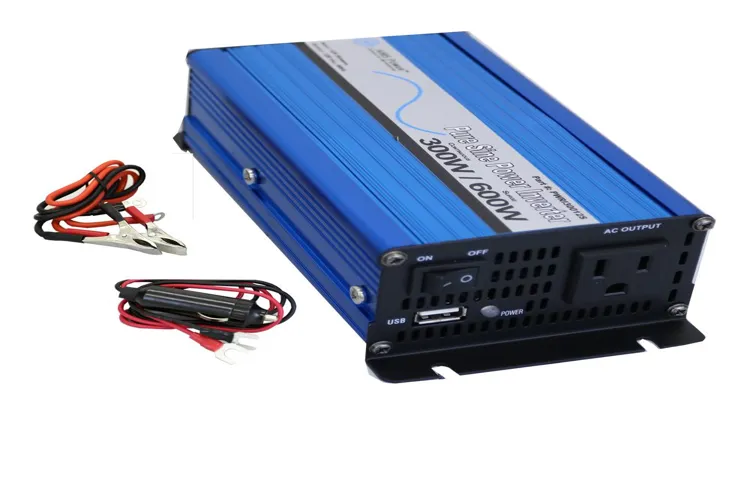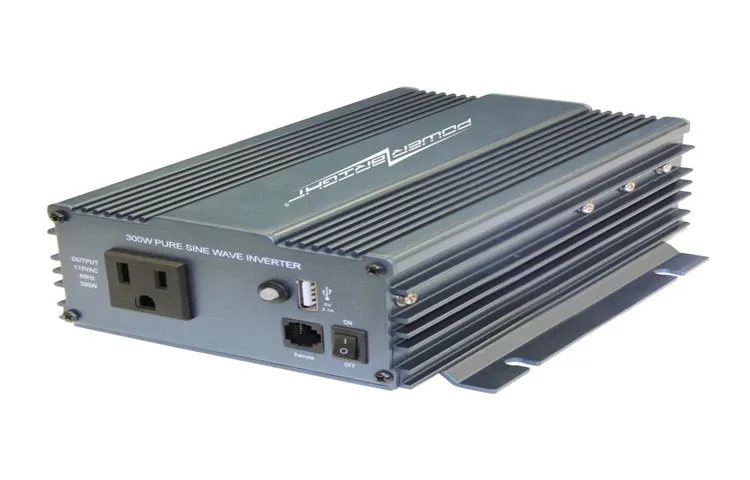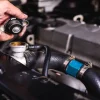Have you ever wondered what you could power with a 300-watt inverter? Well, you’ve come to the right place! Inverter power is essential for anyone on the go, whether you’re camping, traveling in an RV, or simply need a backup power source. But what exactly can a 300-watt inverter handle? Imagine your 300-watt inverter as a superhero capable of transforming your car’s DC power into AC power – like a portable power outlet in your vehicle. This versatile device can power a range of electronic devices, making your life on the road more convenient and comfortable.
Now, you might be thinking, “What can I really power with only 300 watts?” You’d be surprised! A 300-watt inverter can handle various low-power devices such as laptops, small televisions, gaming consoles, DVD players, smartphones, tablets, and even portable fans. So whether you need to browse the internet, watch a movie, play video games, or keep cool during hot summer days, your 300-watt inverter has got you covered! It’s important to note that not all devices will require the full 300 watts of power. For example, a typical laptop may only consume around 50 to 100 watts, while a small television might use up to 150 watts.
This means you can power multiple devices simultaneously, as long as their combined wattage is within the inverter’s capacity. Now, you’re probably wondering about more power-hungry devices like refrigerators or microwave ovens. Unfortunately, a 300-watt inverter may not be sufficient for those.
Refrigerators typically require around 600 to 800 watts to run, while microwaves can consume 800 to 1,200 watts. These larger appliances would be better suited for a higher-wattage inverter. In conclusion, a 300-watt inverter is a versatile tool that can power a wide range of low-power electronic devices, providing you with comfort and convenience while on the go.
So, whether you’re enjoying a camping trip, road-tripping cross-country, or simply need a backup power source, your 300-watt inverter is here to save the day!
Table of Contents
Understanding Inverters
If you’re wondering what a 300 watt inverter can power, you’re in the right place. A 300 watt inverter is a small but mighty device that can be used to convert DC power from a battery into AC power that can be used to power various electronic devices. While the exact power capabilities of a 300 watt inverter will depend on factors such as the efficiency of the inverter and the specific devices being powered, it can generally handle small electronic devices such as laptops, smartphones, tablets, and small kitchen appliances like blenders or coffee makers.
It’s important to note, however, that larger appliances or power-hungry devices like refrigerators or air conditioners will likely require a more powerful inverter. Nonetheless, a 300 watt inverter can be a great option for powering essential devices during power outages or when you’re on the go.
What is an Inverter?
inverter An inverter is a device that converts Direct Current (DC) power into Alternating Current (AC) power. It is an essential component in many electrical systems, especially in renewable energy systems such as solar panels and wind turbines. Inverters play a vital role in converting the DC power generated by these systems into AC power that can be used in homes and businesses.
Think of an inverter as a translator between two different languages – the DC language and the AC language. It takes the language that the renewable energy system speaks (DC) and translates it into a language that our appliances and electronics understand (AC). This allows us to use the power generated from renewable sources to power our homes and businesses.
Inverters come in different sizes and types, depending on the specific application. Some are small and portable, designed for use with car batteries, while others are larger and more powerful, suitable for grid-tied solar systems. They can also vary in terms of their efficiency, with some inverters being more efficient at converting DC to AC power than others.
In addition to converting power, inverters also play other important roles. They often include features such as voltage regulation and protection against power surges. This helps ensure that the electricity being supplied is stable and safe for use by our appliances and devices.
In conclusion, inverters are crucial devices that allow us to make the most of the power generated by renewable energy systems. They act as translators, converting DC power into AC power that can be used to power our homes and businesses. Understanding inverters and their importance is essential for anyone looking to harness the power of renewable energy.

How Does an Inverter Work?
inverter, power supply, electricity, DC, AC, electronic devices Have you ever wondered how your electronic devices can work even when there’s a power outage? The answer lies in the humble inverter. An inverter is a device that converts the direct current (DC) from a power supply, such as a battery, into alternating current (AC) that is used to power electronic devices. In simple terms, it takes the electricity from a battery and changes it into a form that can be used by your appliances and gadgets.
So how does an inverter work? Well, it all starts with the DC power from the battery being fed into the inverter. Inside the inverter, there are electronic components like transistors and capacitors that manipulate the flow of electricity. These components work together to create a waveform that mimics the pattern of AC power.
This waveform is then sent out from the inverter to power your devices. But why do we need to convert the DC power into AC power? The reason is that most electronic devices are designed to run on AC power. AC power oscillates back and forth in a wave-like motion, and this is what allows our appliances to function properly.
By converting the DC power into AC power, the inverter ensures that our devices receive the correct type of electricity they need to operate. Inverters are crucial in various situations, such as during power outages or in remote locations where access to the electrical grid is limited. They allow us to continue using our electronic devices, providing power when we need it the most.
Without inverters, many of our gadgets, from smartphones to refrigerators, would be rendered useless. In conclusion, an inverter is a device that converts DC power into AC power, allowing us to power our electronic devices. It is essential for ensuring that our devices can function even when there is no direct supply of electricity.
So the next time you use your smartphone during a power outage, remember to thank the inverter that is quietly working in the background, making it all possible.
Different Types of Inverters
inverters, types of inverters, different types of inverters, understanding inverters
Determining Power Requirements
If you’re wondering what a 300 watt inverter can power, you’re in the right place! A 300 watt inverter is a handy device that can convert DC power from a car or battery into AC power, allowing you to use electronic devices while on the go. So what can it power? Well, it all depends on the wattage requirements of the devices you want to use. A 300 watt inverter can handle small to medium-sized electronics such as laptops, smartphones, tablets, and small appliances like fans or lamps.
However, it may not be able to handle power-hungry devices such as refrigerators or power tools which require higher wattage. It’s always a good idea to check the power requirements of the devices you want to use and make sure that they fall within the capacity of your inverter.
Calculating Power Consumption
power consumption, determining power requirements, calculate power usage, energy efficiency, reduce energy consumption Determining the power requirements of your devices is important for effective energy management and reducing your overall power consumption. By understanding how much power each of your devices uses, you can make informed decisions about energy efficiency and reduce unnecessary energy consumption. To calculate power usage, you can start by checking the labels or specifications provided by the manufacturer.
These labels often include information like the device’s voltage and current ratings. By multiplying these values together, you can calculate the power in watts (P = V x I). Additionally, you can use power meters or energy monitoring devices to measure real-time power consumption.
This can help you identify any devices that are using excessive power and allow you to make adjustments to improve energy efficiency. By taking the time to calculate and monitor power consumption, you can take steps towards reducing your energy usage and creating a more sustainable environment.
Considerations for Electrical Devices
When it comes to determining the power requirements for electrical devices, there are a few things to consider. First and foremost, you need to know how much power the device will consume when it is in use. This is typically measured in watts and can usually be found in the device’s specifications or user manual.
It’s important to note that different devices will have different power requirements, so it’s crucial to do your research and find the specific power requirements for each device you plan to use. Additionally, you should also take into account any additional power needs that the device might have, such as power for charging or powering peripheral devices. By taking the time to carefully consider the power requirements of your electrical devices, you can ensure that you have the necessary power supply to keep everything running smoothly.
Safety Precautions
Determining Power Requirements for Safety Precautions When it comes to safety precautions, one important aspect that often gets overlooked is determining the power requirements. Whether you’re working with electrical appliances, power tools, or any other equipment that requires electricity, it’s crucial to ensure that you have the right power supply. Determining power requirements is like knowing how much fuel your car needs to reach its destination without running out.
You don’t want to overload your electrical circuits, risking the chance of electrical fires or damaging your equipment. On the other hand, you don’t want to have insufficient power, causing your devices to underperform or fail to function altogether. To determine your power requirements, you need to consider a few factors.
First, you’ll need to know the voltage rating of your equipment. This is usually indicated on the device or in the user manual. Next, you’ll need to determine the power consumption in watts or amps.
This information can also be found on your equipment or in the user manual. Once you have these details, you can use a simple formula to calculate the power requirements. Multiply the voltage rating by the power consumption to get the required wattage or amperage.
For example, if your device operates at 120 volts and consumes 5 amps, the power requirement would be 600 watts (120 volts * 5 amps = 600 watts). It’s essential to note that some devices may have different power requirements, depending on their usage. For example, a power tool may have a higher power consumption when operating at its maximum capacity compared to when it’s running at a lower setting.
In such cases, it’s important to consider the maximum power requirements to ensure safe operation. By determining the power requirements of your equipment, you can make sure that you have the right power supply and avoid any potential safety hazards. It’s always better to be safe than sorry when it comes to electrical appliances and equipment.
What Can a 300 Watt Inverter Power?
If you’re wondering what a 300 watt inverter can power, you’re in the right place! A 300 watt inverter is a handy tool that can convert DC power from a car battery into AC power that can be used to charge or power various devices. While its power output is modest compared to larger inverters, it can still handle a range of smaller appliances and electronics. For example, a 300 watt inverter can power devices like laptops, mobile phones, tablets, cameras, portable DVD players, and even small home appliances like blenders, coffee makers, or fans.
However, it’s essential to note that the actual power consumption of these devices may vary, so it’s always a good idea to check the wattage requirements of the device you intend to power. Keep in mind that using multiple devices simultaneously may exceed the inverter’s power limit, so it’s crucial to manage your power usage accordingly.
Small Electronics and Appliances
300 watt inverter
Charging Mobile Devices
charging mobile devices
Small Kitchen Appliances
small kitchen appliances, 300 watt inverter, power
Power Tools
300 watt inverter, power tools
Emergency Power
emergency power, 300 watt inverter, power consumption
Choosing the Right Inverter
If you’re wondering what appliances a 300 watt inverter can power, you’ve come to the right place. A 300 watt inverter is a relatively small-sized inverter that can convert DC power from a battery to AC power. With 300 watts of power, you can run small electronic devices such as laptops, smartphones, tablets, and small appliances like a coffee maker or a fan.
However, it’s important to note that the power consumption of different devices can vary, so it’s always a good idea to check the power requirements of the specific device you intend to power before using a 300 watt inverter. Additionally, it’s worth knowing that a 300 watt inverter may not be able to power high-draw appliances like refrigerators, air conditioners, or power tools. It’s best to invest in a higher wattage inverter if you want to power larger devices or multiple devices at the same time.
So, if you’re looking for a compact and portable power solution to run small electronic devices while on the go, a 300 watt inverter could be a perfect fit for you.
Matching Inverter Power to Device Requirements
Matching the power output of an inverter to the requirements of your devices is crucial for optimal performance and efficiency. Choosing the right inverter for the job is an important decision that can save you money and headaches down the line. When selecting an inverter, it is essential to consider the power rating of your devices.
The power rating, typically measured in watts, represents the amount of power a device requires to operate. It is important to choose an inverter that can provide enough power to meet the demands of your devices without overloading the system. An inverter with insufficient power output can lead to poor performance, damage to the devices, or even complete failure.
On the other hand, an inverter with an excessive power output can be a waste of energy and may needlessly increase your electricity bills. To choose the right inverter, start by calculating the total power requirement of all the devices you plan to connect. Make sure to account for any potential peak power demands, such as when devices start up or operate at maximum load.
This will ensure you select an inverter that can handle the bursts of power without causing any issues. Additionally, consider the type of devices you will be connecting to the inverter. Some devices, such as motors or compressors, require a higher starting power than their continuous power rating.
In these cases, it is important to choose an inverter with a higher power rating or one that can accommodate the initial power surge without tripping or shutting down. Lastly, consider any future expansion or additional devices you may want to connect to the inverter. It is always a good idea to choose an inverter that has a bit of extra capacity to accommodate any future power demands.
In conclusion, selecting the right inverter for your device requirements is crucial for optimal performance and efficiency. Consider the power rating of your devices, any potential bursts of power, and any future expansion plans. By taking these factors into account, you can ensure that your inverter matches your device requirements, providing reliable power for all your electrical needs.
Considerations for Backup Power
backup power, inverter, choosing the right inverter
Portable vs. Fixed Installation
“Choosing the Right Inverter: Portable vs. Fixed Installation” When it comes to powering your appliances and electronics during an outdoor adventure or a power outage, having the right inverter is crucial. But which one should you choose: a portable inverter or a fixed installation? Let’s break it down.
If you’re someone who frequently travels or enjoys camping trips, a portable inverter may be the best option for you. Portable inverters are lightweight and easy to transport, allowing you to power your devices wherever you go. They often come with built-in handles or carrying cases, making it convenient to take them on the road.
On the other hand, if you’re looking for a more permanent solution, a fixed installation inverter might be the way to go. These inverters are designed to be permanently mounted in your vehicle or your home. They provide a stable and reliable source of power and can be connected directly to your battery or electrical system.
This means that you don’t have to worry about recharging or replacing batteries, making them ideal for long-term use. So, how do you choose between the two? It ultimately depends on your specific needs and preferences. If you’re someone who enjoys the freedom of being able to power your devices anywhere, anytime, a portable inverter would be a great choice.
However, if you’re looking for a more reliable and hassle-free option, a fixed installation inverter might be more suitable. In conclusion, when it comes to choosing the right inverter, considering whether you need a portable or fixed installation is key. Think about how and where you’ll be using it, as well as the convenience and stability you’re looking for.
By making an informed decision, you can ensure that you have the power you need whenever you need it.
Conclusion
In conclusion, a 300 watt inverter is like the Clark Kent of power devices. While it may not have the strength to move mountains or leap tall buildings in a single bound, it still possesses a superpower all its own. This versatile little device can transform the humble 12-volt DC power supply from your car or boat into a mighty 120-volt AC power source, allowing you to power up a variety of electronic gadgets and small appliances.
From charging your laptop and running a small TV to brewing a perfectly civilized cup of coffee or even saving the day with a hairdryer during a camping trip, the 300 watt inverter is the unsung hero of portable power. So next time you’re in need of a power boost off the grid, trust the mighty but modest 300 watt inverter to save the day with its secret identity and clever capabilities.”
FAQs
What devices can a 300 watt inverter power?
A 300 watt inverter can power small electronic devices such as laptops, smartphones, tablets, and small kitchen appliances like coffee makers or blenders.
Can a 300 watt inverter power a refrigerator?
No, a 300 watt inverter is not powerful enough to run a refrigerator. Typically, refrigerators require inverters with higher wattage, around 1000 watts or more.
How long can a 300 watt inverter power a laptop?
The runtime of a 300 watt inverter powering a laptop will depend on the laptop’s power consumption. On average, a 300 watt inverter can power a laptop for approximately 1-2 hours.
Can a 300 watt inverter power a TV?
Yes, a 300 watt inverter can power most small to medium-sized TVs. However, it is important to check the specific power consumption of your TV to ensure it does not exceed the inverter’s capacity.
Can a 300 watt inverter power a microwave?
No, a 300 watt inverter is not suitable for powering a microwave. Microwaves typically require higher wattage inverters, usually between 800-1500 watts, depending on the microwave’s power rating.
How many devices can a 300 watt inverter power simultaneously?
The number of devices a 300 watt inverter can power simultaneously will depend on the power consumption of each device. It is recommended to calculate the total power consumption and ensure it does not exceed the inverter’s capacity.
Can a 300 watt inverter power a gaming console?
Yes, a 300 watt inverter can power most gaming consoles. However, it is important to consider that gaming consoles, especially newer models, may require additional power for optimal performance.



